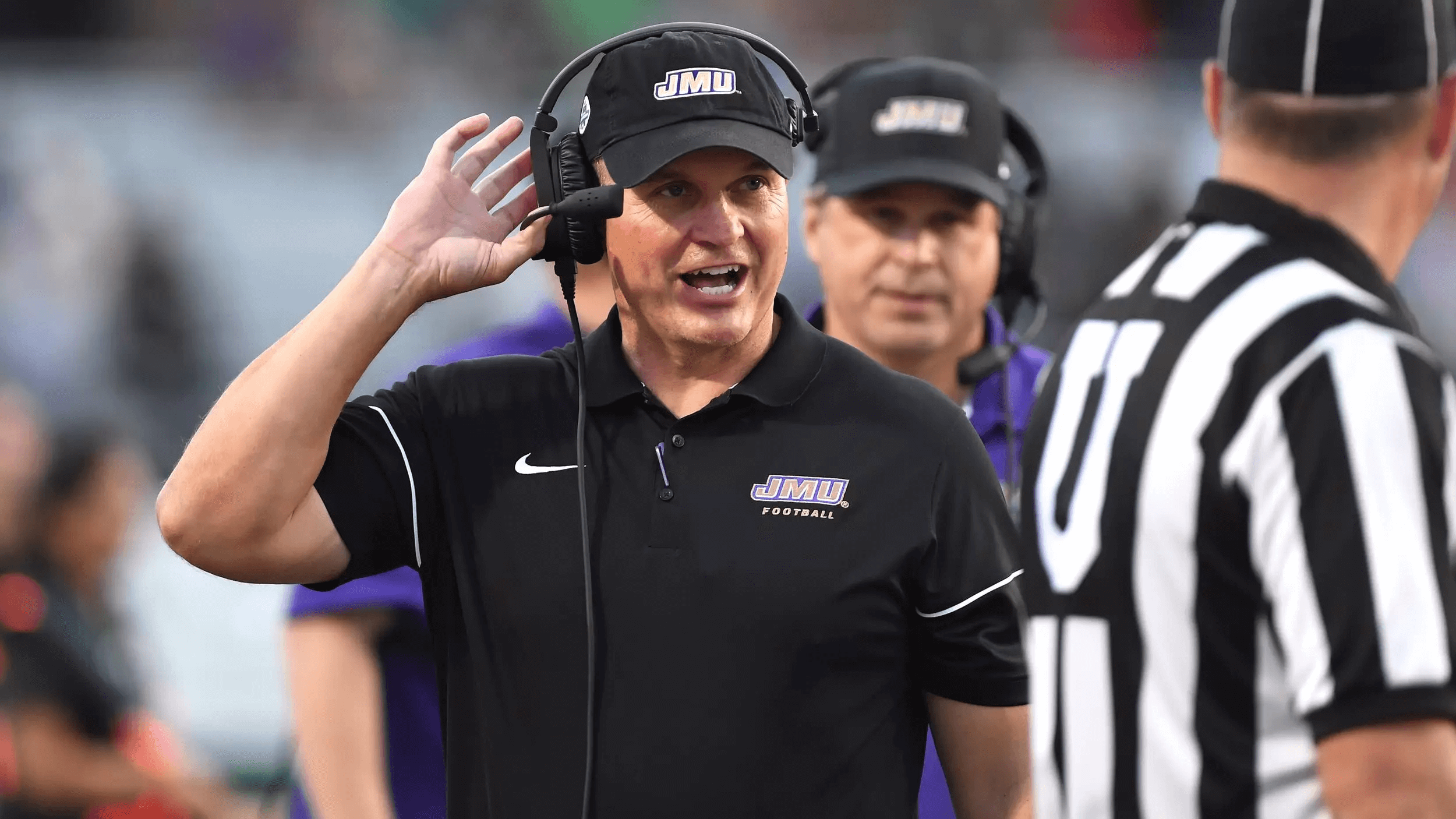JMU’s athletic department has really taken off in the last decade, especially the football program. Everett Withers brought a necessary infusion of swagger and energy into JMU’s athletic department, and he was followed by hard-nosed culture-building leaders in Mike Houston and Curt Cignetti. Now Bob Chesney has the Dukes
The Dukes have been blessed with elite-level football coaches the last decade, and they’ve seen the same across other sports. Mickey Dean was a legendary softball coach, and Loren LaPorte took the program to the Women’s College World Series. Kenny Brooks helped make JMU women’s basketball a mid-major power, and Sean O’Regan has the Dukes maintaining that success. Even men’s basketball head coach Preston Spradlin looks poised to build on an incredible 2023-24 season from Mark Byington and company.
Clearly, the Dukes are in good shape as an athletic department. But what about those coaches who helped shape JMU and then left for bigger jobs. How have they fared? And did they make the right decision to leave? Was the grass really greener outside Harrisonburg?
Let’s break it down from an on-field and financial perspective — coaches move on for personal reasons outside of just team success, but we’ll analyze what we know rather than speculate about other personal reasons for switching jobs. We’re looking at major coaches from the last decade or so, taking the pulse of recent JMU hires and departures.
Everett Withers
Withers spent two short seasons in Harrisonburg and fans love to roast his defense — check out Temple’s defensive stats this season if you want a good chuckle — but he played a big role in JMU’s current success. He revitalized the program by bringing in QB Vad Lee and a high-powered offensive attack with flashy uniforms. He helped engage donors and fans, and College GameDay came to town for the first time with Withers as the team’s head coach. JMU went 18-7 in his two seasons.
He then left for Texas State, where things did not go well.
Withers went a disastrous 7-28 as Texas State’s head coach, getting fired in his third season. He hasn’t been a head coach in the years since, and he’s currently Temple’s defensive coordinator. The Owls are among the worst teams in the Group of Five.
There’s a case to be made that Withers should’ve stuck around at JMU a little longer in an attempt to find a job other than Texas State. It’s hard to win in San Marcos, especially without Texas recruiting connections, and Withers probably bolted from JMU before it was necessary. The Dukes won a national championship the season after Withers left, with Mike Houston helping improve JMU’s defense.
Was the grass greener? No.
Mike Houston
Speaking of Mike Houston, the 2016 national title winner at JMU, he left after the 2018 season for East Carolina. JMU went an impressive 37-6 with Houston leading the program, as he turned the defensive into a dominant force and was exceptionally successful with Bryan Schor at quarterback.
At ECU, Houston went 27-38 before being fired midway through this season. He led the Pirates to a pair of bowl games, and the program was seemingly headed in the right direction after an 8-win 2022 campaign. Consistent recruiting at the FBS level seemed to be an issue for Houston, who couldn’t sustain year-to-year success in part due to roster fluctuations each year.
A 2-10 season in 2023 put him on the hot seat entering this season, and the Pirates floundered to a 3-4 start with a blowout loss to Charlotte. ECU decided to move on, although Houston will likely land another head coaching gig one day. He’s won 106 career games, and he’s shown the ability to win at lower levels.
But was the grass greener? Certainly Houston made more money at ECU than JMU — he was earning over $2 million a year at ECU and well less than $1 million at JMU — but he also missed out on JMU’s move to the FBS and left a program that was spectacular under his watch. While Houston cashed in on an FBS move, it didn’t lead to a Power Five head coaching gig as his next stop. It’s hard to question the move financially, but it was perhaps shortsighted to leave JMU for a Group of Five team in need of a rebuild. Curt Cignetti showed the value of sticking at JMU for numerous seasons and patiently waiting for the right next step.
Was the grass greener? No.
Curt Cignetti
Cignetti cooked at JMU, leading the Dukes to a 52-9 record and transitioning them beautifully into the FBS era. JMU finished first in the Sun Belt East in both FBS seasons with Cignetti leading the team, and the Dukes appeared in the AP Top 25 both years.
Fans were frustrated when Cignetti left for Indiana, taking about a dozen Dukes with him. Some yelled that Indiana could never be relevant in football. Welp.
The Indiana football program began in 1887.
In its first 136 years, the Hoosiers NEVER started a season 9-0.
Now in its 137th year, and Curt Cignetti’s 1st, Indiana is a perfect 9-0.
And all 9 wins have come by at least 14 points.
Historic isn’t even enough to describe it. pic.twitter.com/neqXCdmiZP
— Ben Stevens (@BenScottStevens) November 2, 2024
The Hoosiers are ranked 8th in the latest AP Top 25, as they’re still undefeated and well within the College Football Playoff picture. Cignetti will be in line for a substantial raise — he’s already making $4 million annually — or have more suitors this offseason. He’s a likely candidate to take over any Power Conference job that opens this offseason, if he wants to look at a blueblood program like Florida. He’s quickly become one of the biggest names in coaching, turning Indiana around overnight.
Between money and on-field success, there’s no doubt the early returns suggest Cignetti moved at a good time.
Was the grass greener? So far, it’s a resounding yes.
Kenny Brooks
On the basketball front, Brooks is a JMU legend. Not only did he play at JMU, but he then led the women’s team to 337 wins. He left for Virginia Tech, where he won 180 games and made the Final Four. Now he’s at Kentucky entering Year 1, where he has more resources and could legitimately contend for a national title.
Brooks has not only raised his salary — he’s making about $1.5 million per season at Kentucky which is more than three times what JMU pays Sean O’Regan — but he’s also at a school with realistic national title dreams. He’s one of the top coaches in the country, and he’s received the national recognition he deserves at Virginia Tech and Kentucky.
Was the grass greener? Yes.
Mickey Dean
Dean went an absurd 237-56 at JMU, winning 80% of his games as the Dukes’ coach. He took the school to its first Super Regional, which the Dukes hosted, and nearly got them to the WCWS.
He left after the 2016 season for Auburn, where he had decent success. The Tigers made an NCAA Regional in all of his seasons there, but they never made a Super Regional in those six NCAA appearances. His teams were good, but not great.
Still, he raised his salary significantly ($300,000+ at Auburn compared to about $120,000 per year at JMU) and coached in the SEC. That’s a big deal for a softball coach. While Dean didn’t have monumental success at Auburn — he stepped down after the end of last season — he still won games and made NCAA appearances. He did, however, miss out on the chance to take JMU to the Women’s College World Series for the first time, which would’ve made him a JMU legend.
Was the grass greener? It’s hard to say either way.
Shelley Jaudon, women’s tennis
Jaudon led JMU to CAA titles in 2019 and 2021, the first two conference titles in program history. Last season was her first at Kentucky, and the Wildcats went 9-15.
Did Jaudon make the right move leaving? It’s way too early to tell, but it’s hard to fault anyone — especially a coach of a sport like women’s tennis that doesn’t have quite the JMU same fan support as football, basketball, softball, lacrosse, etc. — for taking an SEC gig with a larger salary. Leaving JMU’s softball program, which sells out games and draws large home crowds, is a bit different than leaving the tennis teams.
Was the grass greener? Time will tell, but Jaudon likely made a smart career move.
Mark Byington, men’s basketball
TBD, but this is an interesting one to monitor. Byington left for a Vanderbilt team capable of winning games in the SEC and making NCAA Tournaments, but he also left a JMU program seemingly on the verge of a nice run as a mid-major. The Dukes have a massive budget compared to many of their mid- and low-major peers in addition to top-notch facilities and a growing NIL Collective. There’s a clear path for JMU to win 20+ games for years to come.
Could Byington have benefitted from waiting another couple years before finding a different Power Conference job? Maybe, although winning at Vanderbilt isn’t impossible and money talks. He’ll make millions at Vanderbilt, compared to hundreds of thousands at JMU.
Was the grass greener? TBD.
Photo courtesy of JMU Athletics Communications


Leave a Reply